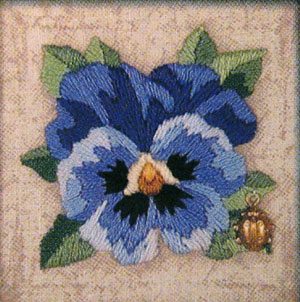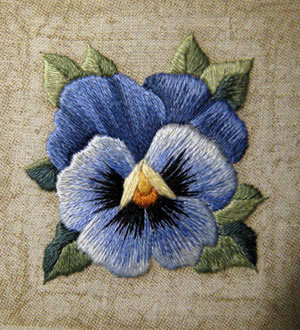Have you ever looked at an embroidery kit, and liked the idea of it, but didn’t like the finished product shown on the front of the kit? Have you ever seen a kit and thought, “If I were going to embroidery something like that, I’d do it differently”? You aren’t alone!
A reader recently sent me two photos of embroidery – one is a photo of the cover of a kit, and the other is a photo of her rendition of the embroidery after she completed the kit.
Gaze in wonder at the difference between these two photos:

This is the photo on the front of the kit. It’s what the finished piece is supposed to look like, after you’ve worked the kit. It’s “cute,” but it’s really blocky and paint-by-number looking. The overall idea of the kit is great, though – I like pansies, and I like embroidered flowers. An embroidered pansy kit would probably be something I’d consider purchasing. But the recommended outcome isn’t exactly my style, so I would pass this up!

When Margaret stitched the kit, she put into practice her knowledge of shading techniques and improved the finished look 100-fold! If I saw a kit with this picture on the front of it, I’d be inclined to get it. The flower is simply more beautiful. It looks like a flower. She did such a pretty and perfect job!
So the moral of the story is, when you see a kit you “kind of” like, look beyond the recommended finished product! You’re the one who is going to work it – who says you have to slavishly follow the absolute directions? If you think you can produce a better finished product, go for it! It will make what was a “mass-market” product more uniquely your own.
Speaking of kits, what do you think about them? Do you use kits? Do you prefer kits? Or do you avoid kits? Do you think using a kit indicates something about the embroiderer? Do you react differently towards a piece of needlework when you find out it was worked from a kit? I’d love to hear what readers think about embroidery kits – if you use them and why, if you don’t and why not, and if you alter them, etc…







While kits certainly have their place, it is usually not in my house. I will occasionally buy a very small kit – on clearance – just to try out a new technique to see if I like it before investing any real money into a project but that’s about it.
Most of the pictures and popular themes right now are not to my taste AT ALL. I’d elaborate but can’t think of how to put it without offending a bunch of people.
I also think most kits are severely overpriced. I have made up kits for our embroidery guild projects, so I know what is involved as far as work and cost – and even if you triple the actual price – to account for manufacturer and designer and distributor and retailer profits – the cost is still only a fraction of what they usually charge. I’m all for letting everyone who worked on it make a reasonable profit, but some are completely unreasonable.
Some brands of kits are also notorious for not providing enough thread, even for frugal stitchers and since they don’t use a commonly marketed thread much of the time, you can’t just go in your stash and make up the difference. To their credit, some of these companies will try to work with you if you contact them, but who needs the hassle and the waiting around for them to do so. They should have made a proper kit to begin with.
As for do I judge stitchers differently who use kits? Well, I do when judging or voting in a show. I will always vote for an original above a kit because choosing your own fibers and colors and stitches takes a heck of a lot more skill and effort than matching ‘+ to yellow’ and ‘* to green’.
Needless to say, I make most of my own designs or adapt public domain images and designs and freebies (I never sell my work or adapted patterns).
Thank you, Pamela, for your candid response! I’m eager to hear what others have to say about kits!
I really think Margaret did an excellent job with this one!
I don’t, as a general rule, buy or use kits but I can see their value in the needlework field.
I think they are an excellent way to introduce a person to needleworks. I would rather a young person work a kit than master a video game.
I think eventually everyone who stays with the needleworks moves away from kits for her own designs or more advanced designs. But, they can be a start to a long love affair with a needle and thread.
To further Pamela’s comment on buying a kit to try out a technique – I want to start working with goldwork soon.
I intend to buy a GoldWork Kit to start with, – maybe even 2 – because the goldwork supplies are so expensive.
I’d like to get my hands on some representational purl, plate etc and gain a little experience in using them, before investing in a small stash so I can work up my own (or historical) designs.
I feel that you can read about the techniques in books but it’s not the same as working with the actual materials yourself.
I was wondering what the backing material used in the pansy kit was?
It looks like the (linen?) was scrunched up and then dyed with coffee.
(Tho you should never dye material or paper with coffee/tea for anything but a temporary fun project, because they are not acid free. In a few years, terrible things will happen to the threads, the metallic ones in particular I think since they tarnish if they aren’t stored in acid free packaging). The alternative is walnut dye.
Anyway, does anyone recognise this backing fabric? I just love it.
Apologies for the babbling – I’ve just done 12 hours straight of embroidery and I can’t quite see straight! *grin*
The fabric is just muslin with printed patterning. It actually looks pretty good. When I first pulled the fabric out of the packaging I thought it was kind of cheesy. 🙂
The best thing about this kit was that I had the opportunity to teach it to two different groups trying to expose them to surface embroidery (with shading). The kit included a matte, glass, and a little stand so you have a truly completed piece when you finish. I was pleased with the results of the classes and I now have people interested in trying some other non-counted work pieces.
Regarding kits….
I think kits have their place and if that’s the only way someone will pick up a needle and apply thread to fabric, that’s good enough for me. I’m not a big fan of doing counted work and most kits are either cross stitch or needlepoint. Finding kits that I want to do has been a challenge, but I’ve done some fun things. Also, the ‘Inspirations’ folks have put out some fabulous kits over the years for which I am really grateful. There are some good designers on-line that have put out some nice designs as well.
I agree that kits are wonderful for learning technique. I think they also have a place in making some needlework supplies available in stores. For example, if there weren’t cross stitch kits with the need to buy floss, you wouldn’t be able to run into a Michael’s and grab some DMC when you need it.
Another thing I like about kits is that I like to have one to take with me when I travel because it’s just so easy!
On the other hand, I am quite tired of kits, especially the commercial ones. I have done a lot of crewel kits and I really don’t like the yarn as supplied; it’s just awful. Also, as was mentioned above, the floss is often of poor quality. I hope to move into ‘doing my own thing’, but won’t rule out a kit if it catches my eye.
I agree with Pamela that kits have their place but it isn’t in my home. I have put together basic “kits” for my granddaughters and even being extremely generous with supplies (I am helping them build a stash) I come no where near the costs of most kits I see in the hobby stores.
I strongly encourage my granddaughters to view what is around them, take pictures with their phones and cameras, develope ideas from these and create their own designs even get squirrely and have fun to do crazy things. A few can draw well a few can’t but it really doesnt matter in the end whether you hand draw something or trace a photo as long as they are stitching what speaks to them is what matters.
I do believe you can take a kit and make it your own as Margaret did here and a beautiful job she did. To me that is much better than the paint by numbers approach. Kits are good for teaching a basic skill of a stitch or approach but once that is accomplished I don’t really care for there use. I know that makes me sound a bit snobbish and I appologize for that. I just think everyone, and I do mean everyone, has something unique inside waiting to bust loose. I really like how Margaret let her uniqueness run with this kit! She is very talented!
As far as do I view others differently who use kits? I would like to say no but if I was judging a competition I would score an original idea higher, I would score someone who used a kit and made it their own higher than one who followed directions exactly as well. At least as long as the basic stitches were of equal skill level. If that makes sense the way I phrased it.
I don’t purchase kits. What I prefer is to use the pattern and perhaps have a list of DMC colors to use. But I like assembling my own materials, most of which I’ve accumulated over the years.